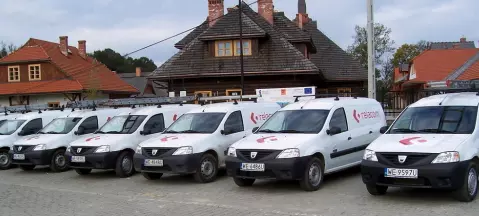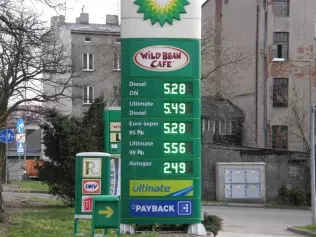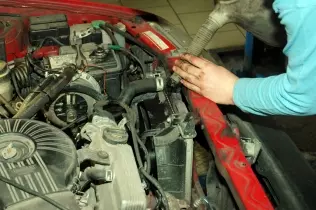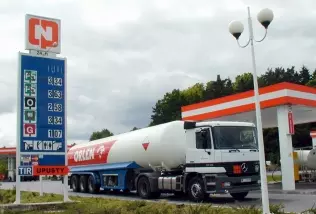- Main page
- Search
- Up to date
- Products
- Technology
- Vehicles
- Video
- Conversion Payback Simulator
Port Injection - Conversion Payback Simulator
Direct Injection - Conversion Payback Simulator
Diesel - Newsletter
LPG fleets - worthwhile or not?
 loading results...
loading results...News concerning lowering prices of petrol and diesel oil by a few cents are a poor consolation for car owners. For fleet owners, who operate sometimes several hundreds of cars, it also doesn’t mean that their operating costs will be much lower. For a 200 car fleet – with each of them powered by diesel oil with 9 l/100 km consumption rate and a monthly mileage of 2500 km – monthly operating costs with the reduction of prices by 0.04 PLN/liter (less than 0.01 EUR) will drop by 1800 PLN (approx. 440 EUR) for the entire fleet. Is it that much from the point of view of a company? It probably is, but real saving starts when companies switch to LPG.
Autogas offers the greatest potential of reducing operating costs related to fuel. Some point out other energy sources, like CNG, others praise electric cars or hybrids (diesel-electric). But in countries like Poland, driving a CNG-powered car is very limited due to poorly developed network of CNG stations, which includes only 32 facilities. It looks better with public transport fleets in cities with a CNG station. Electric cars are also not mobile enough due to total lack of infrastructure for charging batteries. You can forget about driving those cars around the country, as traditional batteries won’t allow you to drive for more than 100 km. Hybrid cars, thanks to a small amount of fuel, can contribute to reducing operating costs of a fleet. But we must remember that they generate biggest savings while driven in urban areas. And their prices compared to conventionally-powered vehicles are much bigger. This also applies to CNG-powered cars and electric vehicles.
That’s why we believe that having an LPG-powered car is the only reasonable way of driving around the country without problems. Why? Because you can reduce operating costs related to fuel consumption by half – and it’s the biggest factor in the overall operating costs of a car. What’s more, LPG stations network is well-developed and consists of almost 6 thousand facilities.
 © gazeo.comOne example of a car factory-equipped with gas system – Kia Picanto LPG has a chance to succeed on the market of small fleet vehicles.
© gazeo.comOne example of a car factory-equipped with gas system – Kia Picanto LPG has a chance to succeed on the market of small fleet vehicles.Why LPG?
Economic factor is obviously the most important reason why fleet operators should consider switching to LPG. But we must also remember that this goes hand in hand with reducing emissions of harmful exhaust gases. It is assumed that emission of carbon monoxide drops by 60% on average. In the case of hydrocarbons and nitrogen oxides, emission can be halved, whereas carbon dioxide’s emission goes down by 10%. It may be an additional factor for companies that like to emphasize their eco-friendliness or offer organic products.
Myths
Any discussion with people who claim that “gas stinks”, “it’s good only for heating” or that “the only ones who drive gas-powered vehicles are poor people who can’t afford buying petrol” is pointless. Any reasonable fleet owner hearing such opinions will at least try to verify them, for example by reading the rest of this text.
Facts
LPG is as good energy source as any other type of fuel and may be used to power internal combustion engines without any problems, having at the same time a couple of positive characteristic features. First of all, it’s octane number is higher than that of petrol, which tells us about each fuel’s knock resistance. LPG is fed into combustion chambers in the form of gas, thanks to which, there’s no risk of dilution of engine oil (as is in the case of liquid fuels), and the oil film is not washed off when the engine is reaching its thermal equilibrium working on gas (no increased wear on cylinder bearing surface at that time). Additional benefit of using LPG in the gas phase is that it mixes better with air. The air-fuel mixture that is created this way is more homogenous (it burns better). Increasing flexibility of an LPG-powered engine is also an important factor for drivers. It means the process of combusting the gas-air mixture is longer and the maximum combustion pressure is lower. Thanks to this, the crank-piston system of an engine is subject to less strain. Due to lengthy combustion (gas burns slower than petrol), some opponents of gas supply systems focus their attention on higher heat load, especially in the head. It is true that gas burns in a slightly higher temperature, but cooling systems in most engines are perfectly capable of taking care of it. However, in some cars, it may cause higher wear of valve seats due to the use of less durable materials.
 © gazeo.comThe LPG-powered Mercedes Sprinter LGT had the chance to conquer the fleet market thanks to proper calculation of the price, which was the same as in the case of its diesel equivalent
© gazeo.comThe LPG-powered Mercedes Sprinter LGT had the chance to conquer the fleet market thanks to proper calculation of the price, which was the same as in the case of its diesel equivalentService availability
Fleets generally have new vehicles operated in a 7-year cycle due to leasing period. These vehicles are taken care of by authorized service points of a particular brand. Thanks to this, fleet operators can sleep peacefully. Cars are handled in those authorized service points but what if the gas system fails?
Currently, a couple of brands offer cars factory-equipped with gas supply systems. These systems are mounted in service points immediately after a car is purchased, new vehicles with gas systems already in place may be also delivered straight from the plant. In both cases, they are in no way inferior to vehicles powered by different types of fuel and – what’s most important – they are fully warranted by car manufacturers. Regardless of the time and place of adaptation to gas supply, within the warranty period and after its end, cars may be serviced in an authorized service point of a particular brand. It’s very important as fleet vehicles often drive around countries, and with their large mileage they visit service points quite frequently, if only because of periodical check-ups.
Good service availability is not restricted to cars factory-equipped with gas systems. More and more companies that supply gas systems, create their own networks of service stations, where service is carried out just like in authorized service points of car manufacturers, regardless of where exactly within this network the gas supply system was mounted.
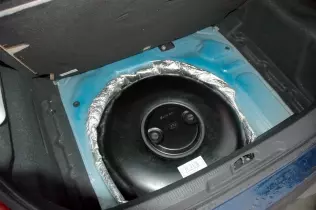 © gazeo.comThe most common place where LPG tanks are mounted (not only in fleet cars) is the spare wheel well
© gazeo.comThe most common place where LPG tanks are mounted (not only in fleet cars) is the spare wheel wellStereotypes
Most opinions about gas supply systems among fleet owners date back to the distant past, where gas supply systems were much different. Solutions used back then were not as precise as those used today, so they might have caused some problems. However, with service check-ups done on time (these serve as prevention that allows to detect first symptoms of possible future problems), even cars with basic gas supply systems can reach high mileage without any problems.
Fuel quality
Properties of gas fuel are regulated by applicable standards, and LPG used as engine fuel is monitored and controlled for its quality. Currently, autogas has the smallest percentage of irregularities among all types of fuel. Without a doubt, this is also reflected in a reduced failure rate of gas supply systems.
Fuel cards used widely in large vehicle fleets allow for easy settlement of operating costs related to fuel. These cards are supported by large fuel companies, which is an additional guarantee of LPG’s quality.
Shortcomings
The only logical argument against gas supply is the fact that an LPG tank limits cargo space in a car. But that doesn’t mean there’s nothing that can be done here. Mounting a toroidal tank and using tire repair kit solves the problem, though we may imagine that some people like to have a spare wheel “aboard”.
Increased operating costs
For some users, increased cost is the main argument for being against LPG. But these costs are not as high as one would expect. What’s more, they are spread over a fairly long time, and ongoing savings made on driving on LPG fully compensate those costs.
Technical check-ups
This is also an argument often mentioned by LPG opponents. Due to the use of a gas supply system, cars have to be subjected to technical check-ups each year, despite the fact that the first check-up in a new car (without gas system) is supposed to be done after three years, the next one two years later, and only after five years the check-ups are to be done on annual basis. It means that a gas-powered car will be subjected to 5 technical check-ups during 5 years of operation (5 x 161 PLN gives us 805 PLN, approx. 200 EUR), whereas a new conventionally powered vehicle (diesel oil or petrol) will have two such check-ups, 98 PLN each (196 PLN total, approx. 50 EUR).
Service
A car with gas-powered engine does not require any additional maintenance, unless manually adjustable valve clearance was installed in the timing gear system. In the case of gas supply, frequent check-ups of the system are recommended, which slightly increases maintenance costs. It’s hard to mention specific amount of money, because sometimes a check-up is limited only to a valve clearance check, without having to adjust it or replace regulatory elements. It may be about 200-300 PLN (50-75 EUR) more than in the case of a petrol-powered engine (labor, regulatory plates, valve cover gasket).
Reduced operating costs
Going back to our earlier calculations – 200 vehicles powered by diesel oil with an average fuel consumption of 9 l/100 km and monthly mileage of 2500 km – monthly operating costs with current prices of diesel oil (4,93 PLN) are 1109.25 PLN (270 EUR). In the case of LPG-powered cars (with its price at 2,41 PLN), monthly operating costs related to fuel for one car are 662,75 PLN (162 EUR). The difference is over 446 PLN (approx. 108 EUR) for each car, so it’s more than the cost of first check-up with valves adjustment or the costs of technical check-ups for 3 years. Multiplying those savings by 200 cars, we’re getting a sum of 89330 PLN (21780) per month.
Summary
In the face of arguments presented above, our answer to the question in the title of this article is: yes, by all means, it is worth it! And the numbers mentioned above prove it. Companies that decided to switch to autogas record serious savings, allowing them to expand their fleet faster or to replace it earlier. In addition, by reducing operating costs, these companies can effectively compete with their rivals.
